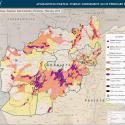 |
 |
Afghanistan Partial Threat Assessment: February 23, 2016

Security in Afghanistan has been deteriorating since U.S. force levels dropped from a high of 100,000 in 2011 to the current force size of 9,800 they reached in June 2014. Lt. Gen. John W. “Mick” Nicholson, the incoming commander of Operation Resolute Support and U.S. Forces in Afghanistan, agreed with the remark that “the security situation in Afghanistan has been deteriorating rather than improving” in a Senate Armed Services Committee (SASC) hearing on January 28. Outgoing Resolute Support Commander General John Campbell reiterated this concern on February 2, stating that the ability to train Afghan security forces will be “very limited” if U.S. forces are reduced to 5,500 by the end of January 2017 as planned.Taliban militants are capitalizing on the overextension of the Afghanistan National Security Forces (ANSF) and dearth of U.S. and NATO forces to increase attacks, particularly in Helmand Province.
ISW last published its Afghanistan Threat Assessment on December 11, 2015. Since then, Taliban militants have regained much of their traditional stronghold of Helmand Province, taking control of Now Zad and Musa Qal’ah Districts after ANSF withdrew between February 20 and 22. Militants are also besieging ANSF in Sangin and Marjah Districts while attacking ANSF near Gereshk, the district center of Nahr-e Saraj. The Taliban is thereby gaining freedom of maneuver around Helmand’s provincial capital, Lashkar Gah, even though they do not control the city itself. The gains are not limited to Helmand alone. Taliban militants are also exploiting the ANSF’s lack of capacity to increase attacks and expand territorial control in rural areas of northern Afghanistan, administering judicial governance in Baghdis, Ghor, Faryab and Sar-e Pul Provinces.
The ANSF nevertheless made substantial gains against ISIS in eastern Afghanistan. The ANSF supported by U.S. airstrikes successfully dislodged ISIS from its primary base in Achin District in southern Nangarhar Province during late February 2016. U.S. forces were able significantly to increase airstrikes on ISIS positions in support of ANSF ground operations because the Obama Administration gave them new authorities to do so in late December 2015. The clearing of Achin may only disrupt ISIS, however, which has continued recruitment south of Kabul, namely in Logar, Ghazni and Paktika Provinces, where the Taliban and Haqqani Networks have maintained support and control zones in the past. Alternatively, fleeing ISIS militants may cross into Pakistan’s mountainous border areas or may join ISIS-linked forces elsewhere in Afghanistan.
By Caitlin Forrest and Rob Denaburg with Harleen Gambhir